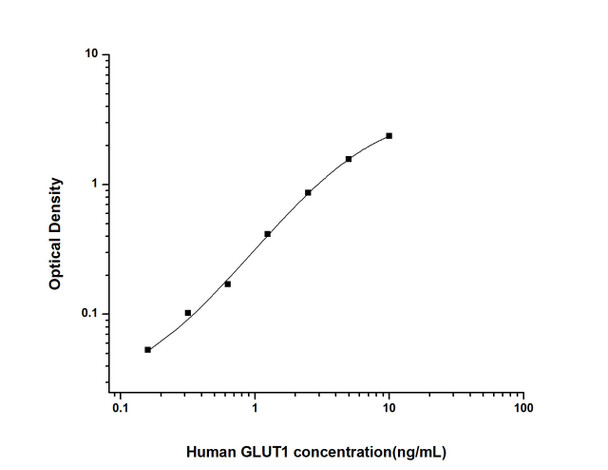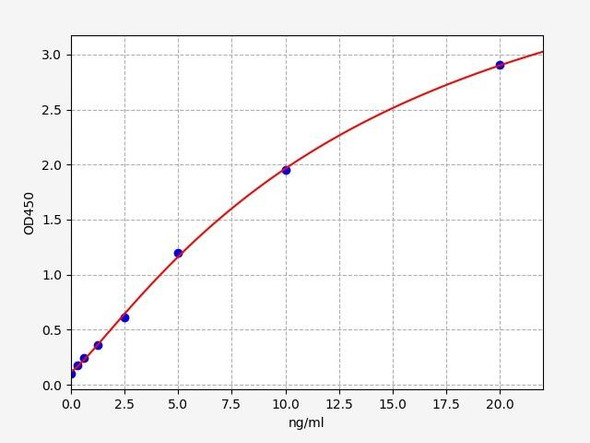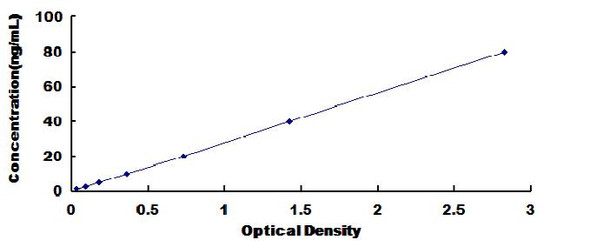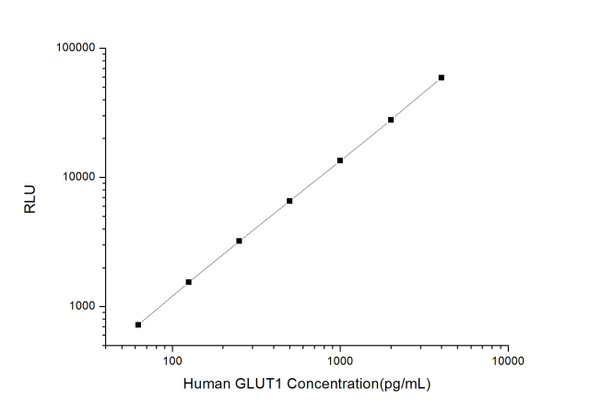Human Signal Transduction ELISA Kits
Human GLUT1 (Glucose Transporter 1) ELISA Kit (HUES02780)
- SKU:
- HUES02780
- Product Type:
- ELISA Kit
- Size:
- 96 Assays
- Uniprot:
- P11166
- Sensitivity:
- 0.09ng/mL
- Range:
- 0.16-10ng/mL
- ELISA Type:
- Sandwich
- Reactivity:
- Human
- Sample Type:
- Serum, plasma and other biological fluids
- Research Area:
- Signal Transduction
Description
| Assay type: | Sandwich |
| Format: | 96T |
| Assay time: | 4.5h |
| Reactivity: | Human |
| Detection Method: | Colormetric |
| Detection Range: | 0.16-10 ng/mL |
| Sensitivity: | 0.10 ng/mL |
| Sample Volume Required Per Well: | 100µL |
| Sample Type: | Serum, plasma and other biological fluids |
| Specificity: | This kit recognizes Human GLUT1 in samples. No significant cross-reactivity or interference between Human GLUT1 and analogues was observed. |
This ELISA kit uses Sandwich-ELISA as the method. The micro ELISA plate provided in this kit has been pre-coated with an antibody specific to Human GLUT1. Standards or samples are added to the appropriate micro ELISA plate wells and combined with the specific antibody. Then a biotinylated detection antibody specific for Human GLUT1 and Avidin-Horseradish Peroxidase (HRP) conjugate are added to each micro plate well successively and incubated. Free components are washed away. The substrate solution is added to each well. Only those wells that contain Human GLUT1, biotinylated detection antibody and Avidin-HRP conjugate will appear blue in color. The enzyme-substrate reaction is terminated by adding Stop Solution and the color turns yellow. The optical density (OD) is measured spectrophotometrically at a wavelength of 450 nm ± 2 nm. The OD value is proportional to the concentration of Human GLUT1. The concentration of Human GLUT1 in samples can be calculated by comparing the OD of the samples to the standard curve.
| UniProt Protein Function: | GLUT1: an integral membrane protein that plays an important role in the glycolytic pathway by serving as a uniporter for glucose. One of 13 members of the human equilibrative glucose transport protein family. Transports a wide range of aldoses, including both pentoses and hexoses, and dehydroascorbic acid. Shown to transport water against an osmotic gradient. A receptor for the Human T-cell Leukemia virus (HTLV). Plays a role in the constitutive or basal uptake of glucose. Expressed at highest levels in proliferating cells of the early developing embryo, cells forming the blood tissue barriers, in human erythrocytes, astrocytes and in cardiac muscle. GLUT1 and GLUT3 are both essential for normal embryonic development. Is practically the only member of the GLUT family expressed on human red blood cells, where it comprises 10 - 20% of the integral membrane protein content. Several glycolytic proteins including the transporters GLUT1 and GLUT3, as well as multiple enzymes including HK2, PFKL, LDHA, ALDOA, ALDOC, PGK1, ENO1, PKM2, CA9 and PFKFB3 are induced in cancer cells by HIF-1 alpha. Polyps from Peutz-Jeghers patients exhibit up-regulated mTORC1 signaling, HIF-1alpha, and GLUT1 levels. Defects in GLUT1 are the cause of autosomal dominant GLUT1 deficiency syndrome, a blood-brain barrier glucose transport defect characterized by infantile seizures, delayed development, and acquired microcephaly. Defects also cause dystonia type 18, an exercise-induced paroxysmal dystonia/dyskinesia. Cytochalasin B binds to its inner surface, inhibiting its glucose transport activity with an IC50 of 0. 44 uM. |
| UniProt Protein Details: | Protein type:Membrane protein, integral; Membrane protein, multi-pass; Transporter; Transporter, SLC family Chromosomal Location of Human Ortholog: 1p34. 2 Cellular Component: cortical actin cytoskeleton; Golgi membrane; integral to plasma membrane; membrane; midbody; plasma membrane Molecular Function:D-glucose transmembrane transporter activity; dehydroascorbic acid transporter activity; glucose transmembrane transporter activity; identical protein binding; protein binding; protein self-association Biological Process: glucose transport; L-ascorbic acid metabolic process; lactose biosynthetic process; protein complex assembly; regulation of insulin secretion Disease: Stomatin-deficient Cryohydrocytosis With Neurologic Defects |
| NCBI Summary: | This gene encodes a major glucose transporter in the mammalian blood-brain barrier. The encoded protein is found primarily in the cell membrane and on the cell surface, where it can also function as a receptor for human T-cell leukemia virus (HTLV) I and II. Mutations in this gene have been found in a family with paroxysmal exertion-induced dyskinesia. [provided by RefSeq, Apr 2013] |
| UniProt Code: | P11166 |
| NCBI GenInfo Identifier: | 115502394 |
| NCBI Gene ID: | 6513 |
| NCBI Accession: | P11166. 2 |
| UniProt Secondary Accession: | P11166,O75535, Q147X2, A8K9S6, B2R620, D3DPX0, |
| UniProt Related Accession: | P11166 |
| Molecular Weight: | 54,084 Da |
| NCBI Full Name: | Solute carrier family 2, facilitated glucose transporter member 1 |
| NCBI Synonym Full Names: | solute carrier family 2 member 1 |
| NCBI Official Symbol: | SLC2A1 |
| NCBI Official Synonym Symbols: | CSE; PED; DYT9; GLUT; DYT17; DYT18; EIG12; GLUT1; HTLVR; GLUT-1; SDCHCN; GLUT1DS |
| NCBI Protein Information: | solute carrier family 2, facilitated glucose transporter member 1 |
| UniProt Protein Name: | Solute carrier family 2, facilitated glucose transporter member 1 |
| UniProt Synonym Protein Names: | Glucose transporter type 1, erythrocyte/brain; GLUT-1; HepG2 glucose transporter |
| Protein Family: | Glucose transporter |
| UniProt Gene Name: | SLC2A1 |
As the OD values of the standard curve may vary according to the conditions of the actual assay performance (e. g. operator, pipetting technique, washing technique or temperature effects), the operator should establish a standard curve for each test. Typical standard curve and data is provided below for reference only.
| Concentration (ng/mL) | O.D | Average | Corrected |
| 10 | 2.425 2.463 | 2.444 | 2.359 |
| 5 | 1.643 1.663 | 1.653 | 1.568 |
| 2.5 | 0.962 0.928 | 0.945 | 0.86 |
| 1.25 | 0.495 0.501 | 0.498 | 0.413 |
| 0.63 | 0.269 0.241 | 0.255 | 0.17 |
| 0.32 | 0.191 0.183 | 0.187 | 0.102 |
| 0.16 | 0.131 0.145 | 0.138 | 0.053 |
| 0 | 0.079 0.091 | 0.085 | -- |
Precision
Intra-assay Precision (Precision within an assay): 3 samples with low, mid range and high level Human GLUT1 were tested 20 times on one plate, respectively.
Inter-assay Precision (Precision between assays): 3 samples with low, mid range and high level Human GLUT1 were tested on 3 different plates, 20 replicates in each plate.
| Intra-assay Precision | Inter-assay Precision | |||||
| Sample | 1 | 2 | 3 | 1 | 2 | 3 |
| n | 20 | 20 | 20 | 20 | 20 | 20 |
| Mean (ng/mL) | 0.49 | 0.89 | 4.44 | 0.50 | 0.86 | 4.60 |
| Standard deviation | 0.03 | 0.04 | 0.19 | 0.03 | 0.05 | 0.17 |
| C V (%) | 6.12 | 4.49 | 4.28 | 6.00 | 5.81 | 3.70 |
Recovery
The recovery of Human GLUT1 spiked at three different levels in samples throughout the range of the assay was evaluated in various matrices.
| Sample Type | Range (%) | Average Recovery (%) |
| Serum (n=5) | 94-108 | 99 |
| EDTA plasma (n=5) | 90-101 | 96 |
| Cell culture media (n=5) | 85-98 | 92 |
Linearity
Samples were spiked with high concentrations of Human GLUT1 and diluted with Reference Standard & Sample Diluent to produce samples with values within the range of the assay.
| Serum (n=5) | EDTA plasma (n=5) | Cell culture media (n=5) | ||
| 1:2 | Range (%) | 90-100 | 93-109 | 96-111 |
| Average (%) | 95 | 100 | 103 | |
| 1:4 | Range (%) | 91-106 | 87-101 | 83-96 |
| Average (%) | 97 | 93 | 90 | |
| 1:8 | Range (%) | 93-106 | 82-98 | 87-99 |
| Average (%) | 99 | 89 | 93 | |
| 1:16 | Range (%) | 88-104 | 85-101 | 84-94 |
| Average (%) | 95 | 92 | 89 |
An unopened kit can be stored at 4°C for 1 month. If the kit is not used within 1 month, store the items separately according to the following conditions once the kit is received.
| Item | Specifications | Storage |
| Micro ELISA Plate(Dismountable) | 8 wells ×12 strips | -20°C, 6 months |
| Reference Standard | 2 vials | |
| Concentrated Biotinylated Detection Ab (100×) | 1 vial, 120 µL | |
| Concentrated HRP Conjugate (100×) | 1 vial, 120 µL | -20°C(shading light), 6 months |
| Reference Standard & Sample Diluent | 1 vial, 20 mL | 4°C, 6 months |
| Biotinylated Detection Ab Diluent | 1 vial, 14 mL | |
| HRP Conjugate Diluent | 1 vial, 14 mL | |
| Concentrated Wash Buffer (25×) | 1 vial, 30 mL | |
| Substrate Reagent | 1 vial, 10 mL | 4°C(shading light) |
| Stop Solution | 1 vial, 10 mL | 4°C |
| Plate Sealer | 5 pieces | |
| Product Description | 1 copy | |
| Certificate of Analysis | 1 copy |
- Set standard, test sample and control (zero) wells on the pre-coated plate and record theirpositions. It is recommended to measure each standard and sample in duplicate. Note: addall solutions to the bottom of the plate wells while avoiding contact with the well walls. Ensuresolutions do not foam when adding to the wells.
- Aliquot 100µl of standard solutions into the standard wells.
- Add 100µl of Sample / Standard dilution buffer into the control (zero) well.
- Add 100µl of properly diluted sample (serum, plasma, tissue homogenates and otherbiological fluids) into test sample wells.
- Cover the plate with the sealer provided in the kit and incubate for 90 min at 37°C.
- Aspirate the liquid from each well, do not wash. Immediately add 100µL of BiotinylatedDetection Ab working solution to each well. Cover the plate with a plate seal and gently mix. Incubate for 1 hour at 37°C.
- Aspirate or decant the solution from the plate and add 350µL of wash buffer to each welland incubate for 1-2 minutes at room temperature. Aspirate the solution from each well andclap the plate on absorbent filter paper to dry. Repeat this process 3 times. Note: a microplatewasher can be used in this step and other wash steps.
- Add 100µL of HRP Conjugate working solution to each well. Cover with a plate seal andincubate for 30 min at 37°C.
- Aspirate or decant the solution from each well. Repeat the wash process for five times asconducted in step 7.
- Add 90µL of Substrate Reagent to each well. Cover with a new plate seal and incubate forapproximately 15 min at 37°C. Protect the plate from light. Note: the reaction time can beshortened or extended according to the actual color change, but not by more than 30min.
- Add 50 µL of Stop Solution to each well. Note: Adding the stop solution should be done inthe same order as the substrate solution.
- Determine the optical density (OD value) of each well immediately with a microplate readerset at 450 nm.






